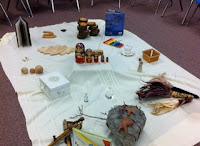A few of us from SD67 have been attending
an inquiry in SD53. A group of early
learning and primary teachers led by Melia Dirk have been meeting together to
talk about provocations, and how to build classrooms that foster inquiry. At this last meeting, teachers shared how
they have used different materials to stimulate play, curiousity, writing,
building and story. We saw examples of
tables covered with nature materials, shells and sand, jewels, animals, art
supplies. Some teachers put the
materials on mirrors or light tables to add different kinds of exploration. Other teachers used story stones to stimulate
writing and story telling; one teacher is taking her class outside every
Wednesday to explore nature and write about it. Last week her students
investigated animal tracks in the snow.
 |
| Materials used to stimulate connections and memories |
“The Reggio Emilia Approach is an
educational philosophy focused on preschool and primary
education.
It was developed after World War II by a teacher, Loris Malaguzzi, and
parents in the villages around Reggio Emilia in Italy. Following the war, people
believed that children were in need of a new way of learning. The
assumption of Malaguzzi and the parents was that people form their own
personality during early years of development and that children are endowed
with "a hundred languages" through which they can express their
ideas. The aim of this approach is teaching how to use these symbolic languages
(eg., painting, sculpting, drama) in everyday life. The program is based on
the principles of respect, responsibility, and community through exploration
and discovery in a supportive and enriching environment based on the interests
of the children through a self-guided curriculum.”
When I watched some of the video clips from
the Opal School I was intrigued with how well it connects with Through a Different Lens; Younger kids,
but a similar approach. Opal School
seems proud that they are addressing the needs of all students – and doing it
by allowing them to express their learning in many different ways. That sounds very familiar to many in SD67.
We are in an
exciting time in education - so much to learn and be curious about ourselves.
submitted by Judith King

I too recognize the connections to the work being pursued in the Through a Different Lens classrooms. I am encouraged to see that we are sharing our learning with other districts. An important consideration as we move forward into a revised curriculum.
ReplyDelete